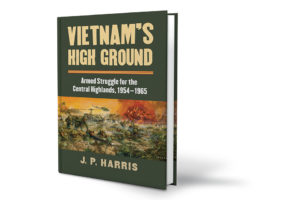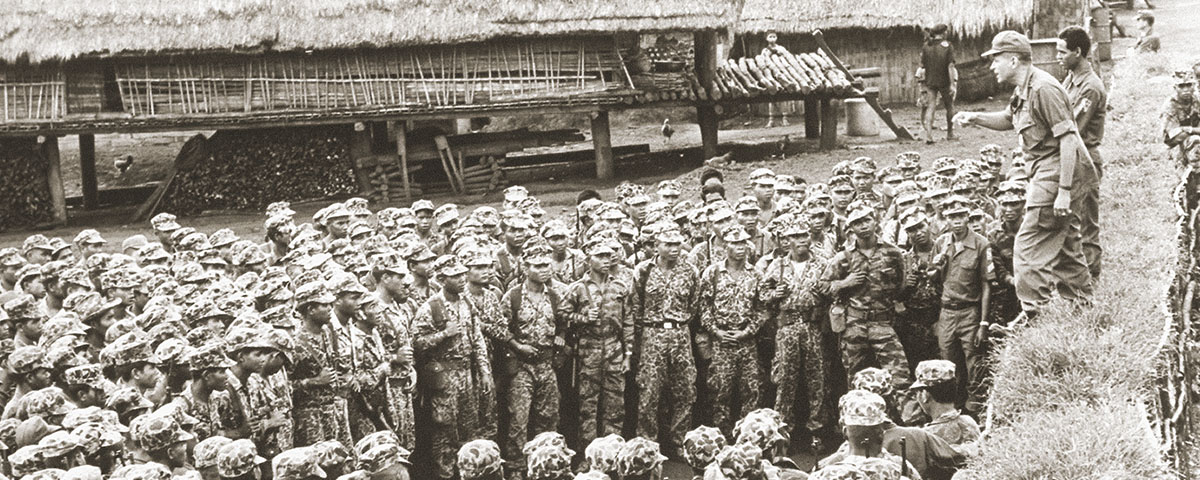“Take the high ground” is one of the oldest and truest maxims of military operations. During the Vietnam War that strategic high ground was the Central Highlands, the 26,000 square miles that constitute the southern end of the Annamite mountain chain, forming South Vietnam’s border with Laos and part of its border with Cambodia. Mountainous and interspersed with high plateaus, the Central Highlands were a perfect staging area for North Vietnamese troops who moved down the Ho Chi Minh Trail and entered South Vietnam across the borders of its nominally “neutral” neighbors to the west.
 The sparse population consisted largely of various highland ethnic groups. Often collectively called Montagnards, they were in fact an assortment of very different peoples, with their own distinct languages and cultures. Most did not see themselves as Vietnamese, nor did they identify with Vietnamese nationalism. The Vietnamese, on the other hand, looked down on the Hill Peoples as inferior primitives. Much of the Vietnam War centered on the struggle to control this strategic terrain and gain the support of its indigenous populations.
The sparse population consisted largely of various highland ethnic groups. Often collectively called Montagnards, they were in fact an assortment of very different peoples, with their own distinct languages and cultures. Most did not see themselves as Vietnamese, nor did they identify with Vietnamese nationalism. The Vietnamese, on the other hand, looked down on the Hill Peoples as inferior primitives. Much of the Vietnam War centered on the struggle to control this strategic terrain and gain the support of its indigenous populations.
American historical focus on the Central Highlands generally starts with the large-scale operations of the 1st Cavalry Division (Airmobile) in late 1965 and its brutal battles at landing zones X-Ray and Albany during the Ia Drang Campaign. But as John Paul Harris points out in Vietnam’s High Ground: Armed Struggle for the Central Highlands, 1954-1965, the fighting in that region had been going on for 10 years before the 1st Air Cav appeared on the scene, and virtually everything that played out there during the subsequent decade was directly influenced by what happened during that earlier phase. Yet very little historical analysis has been devoted to that crucial 1954-65 period. Harris fills that gap with a masterful analysis of how and why the stage was set for the large-scale American involvement in the struggle for that key high ground.
Throughout the 1950s both Saigon and Hanoi contended for the loyalty of the Hill Peoples, but South Vietnamese hostility toward the Montagnards’ aspirations for autonomy severely handicapped the anti-communist side. David Nuttle, an American agricultural expert with the International Voluntary Service working with the Highlands Rhade people, developed an innovative and effective local self-defense scheme with the support of the CIA. But officials in Saigon were leery of arming any of the Hill Peoples.
Eventually the Rhade Project was diluted to the point of ineffectiveness. Later, however, U.S. Special Forces took control of the project and expanded it far beyond the Central Highlands into what became the Civilian Irregular Defense Group program.
North Vietnamese Army units first entered the Central Highlands in January 1961. Despite the NVA’s reputation for being able to operate in the most primitive of areas, the soldiers from the north had a very hard time living in a region that was able to sustain even the relatively small indigenous population at only subsistence levels.
Throughout the early 1960s, the Army of the Republic of Vietnam, with U.S. advisers operating in the Central Highlands, actually fought rather well against the NVA in many instances. During the attack on the U.S. Special Forces camp at Kannack on March 8, 1965, for example, more communist troops were killed than during the fights against the 1st Air Cav at LZ X-Ray or LZ Albany eight months later.
The struggle for the Highlands continued after the American pullout in early 1973. In April 1975, the South Vietnamese defeat at Ban Me Thuot resulted in the Saigon government’s decision to abandon the Central Highlands. North Vietnamese regular forces then cut South Vietnam in two, and the fall of South Vietnam followed closely behind.
A longtime instructor at the Royal Military Academy Sandhurst and author of a previous military history book that won Britain’s prestigious Templer Prize, Harris delivers a clear narrative based on extensive research into both American and North Vietnamese records. He was assisted admirably with the Vietnamese sources by Merle Pribbenow, a retired CIA officer who was stationed in Saigon during the war.
Noting the characteristic hyperbole of communist records and the many gaps and conflicts in the American records, Harris’ critical analysis strikes a credible middle ground. Of special interest are the serious unanswered questions he raises about the overall American command and control during the Ia Drang Campaign.
This book is intriguing reading and one of the most important works about the Vietnam War to come out in many years.





